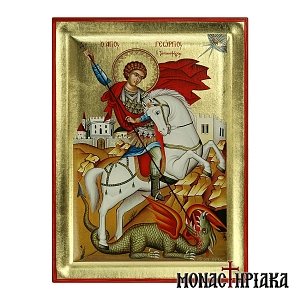Where is the Holy Monastery of Zografou and who are its founders
The Holy Monastery of Zografou is built on an invisible wooded slope of the northwestern side of the Athonian peninsula. It is located at an altitude of 160 meters, it is 40 minutes from the beach, while it is 3.5 hours from Karyes.
The Holy Monastery of Zografou celebrates Saint George (April 23) and is in 9th place in the hierarchy of the monasteries of Mount Athos.
Who are the founders of Monastery of Zografou
According to the tradition, the founders of Zografou Monastery are considered to be three brother monks, Moses, Aaron and John from Ahrida, who lived on Mount Athos in the 10th century.
However, historical evidence testifies to another version of the establishment of the Monastery. In the first charter of Tsimiskis (972), George the Painter (in Greek, Zografos) is mentioned as the builder of the Zografou Monastery, who signs as abbot of the Monastery.
The Zografou Monastery is dedicated to Saint George, as an old miraculous icon is preserved, which is one of the most important relics of the Monastery.
The Holy Monastery of Zografou over the centuries
Historical information about the course of the Monastery up to the 13th century is limited, however we speculate that Bulgarian monks lived there since then.

Crisis at the Holy Monastery of Zografou due to the union of the two Churches
At the end of the same century, the history of Zografou Monastery is stained with blood. Emperor Michael VIII and Patriarch Vekkos ordered the martyrdom of 26 monks from the Zografou Monastery, who refused the union of the two Churches and the unification policy of the state and ecclesiastical authorities.
Nevertheless, Emperor Michael made rich donations to the monastery and helped in its development.
In 1873 a cenotaph was built in memory of these Martyrs of the Zografou Monastery, with an inscription confirming that the events took place in 1276.
Pirate raids hit the Holy Monastery of Zografou
The monastery suffered from raids by Catalan pirates in the period 1307-1309, as a result of which many buildings were destroyed. However, the Monastery soon recovered with the sponsorship and support of the Palaiologos Emperors and the rulers of the Transdanubian countries.
In the 15th century, the ruler of Moldovlachia, Stefanos the Great, decisively helped the Zografou Monastery and offered it a series of metochia.
Until the beginning of the 19th century in the Monastery, together with the Bulgarian monks, there were also Greek and Serbian monks. However, from 1845 onwards, only Bulgarians remained.

The renovation of the Holy Monastery of Zografou and the new buildings
In the period 1862-1896, almost half of the Monastery was renovated. Then the heavy buildings of the northern side with the monks' cells, the propylon and the western wing were added.
The Church of the Monastery was built at the beginning of the 19th century. The frescoes of the Church were done in 1817, while the narthex was done in 1840. North-west of the church is placed the phiale of the Holy Water on eight columns, as well as the chapel of the Dormition of the Virgin, built in 1758-1764.
The refectory (trapeza) was built in 1896 and at a point above there is the Church of Saints Cyril and Methodius.
In recent years, in 1974, the Monastery of Zografou experienced a relatively small fire that destroyed the south side.
Metochia of the Holy Monastery of Zografou
Zografou Monastery has 8 chapels inside the monastery and 8 chapels outside. In previous years, it had metochia in areas of Romania, Bulgaria, Russia and Turkey, but today it only has what is left in the Greek area.
The Library of Monastery of Zografou
The library is located in the tower of the Monastery and includes 126 Greek and 388 Slavic manuscripts, as well as about 10,000 printed books.
Perhaps the most important manuscript of the Monastery is the Bulgarian code no. 17, Rabomir's psalter of the 13th century. Also, three Slavic manuscripts are considered of high historical value: the 13th century Dragan's Calendar with the lives of the martyred Saints, the Slavic codex no. 28, a Tetraevangeli in Slavic from 1569 and finally, the Slavic codex no. 1 of 1745, which essentially constitutes the first recording of the history of Bulgaria by the monk Paisios.
The relics of Monastery of Zografou: the miraculous icons of the Virgin Mary and Saint George 
Heirlooms, vestments, wood carvings, icons and relics of Saints are kept in the sacristy of the Monastery.
Among the famous relics of the Zografou Monastery are the two miraculous icons of Theotokos, Virgin Mary of Akathistos and Virgin Mary of Epakouusa.
In addition, the Holy Monastery of Zografou owns three miraculous icons of Saint George the Great Martyr.
The first icon is associated with the three founders of the Monastery, Moses, Aaron and John. According to tradition, at some point the three brothers were trying to decide which Saint they would tell to be the patron saint of the monastery. Then, they prayed for a divine sign to be sent to them and left a piece of wood in the Temple.
The next day, they returned to the Temple and found the unmade image of Saint George depicted on the board. Thus, they named the Monastery with the name of Zografou (=painter’s), after the icon that was found miraculously painted.
The second icon of Saint George comes from Arabia and is placed on the eastern column in the left choir. This icon has a silver plating made in 1822.
Finally, the third icon of Saint George is placed at the end of the horn of the left choir, in an iconostasis of the Abbot of Moldavia, Stephen, in 1546.
Contact with Monastery of Zografou:
Phone: +30 2377 0 23247













